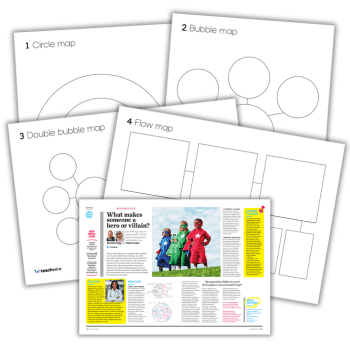How to ensure pupils’ needs are met with the EHCP process

The EHCP process can seem overwhelming but working in partnership with professionals and parents will ensure you're doing your best for students, says Steph Caswell…

- by Steph Caswell
- Coach, author and former deputy headteacher Visit website

When you first embark on your teaching career, you will doubtless have many balls to juggle and plates to spin. An understanding of special educational needs is just one of them.
Unfortunately, providing comprehensive coverage of this complex topic is often lacking in initial training. For newly qualified teachers, SEND can feel very overwhelming.
You’ve been with your class for several months now. You’ve probably got children with a variety of needs sitting among them. You may even have a child with an education, health and care plan (EHCP).
But you may also have a pupil who is currently under assessment for an EHCP – a process that can seem long and involved.
It is, therefore, extremely important that you feel equipped with an understanding of the process and have the confidence to give your valuable input at the appropriate times. Let’s dive in, shall we?
What is an EHCP?
An EHCP is a document designed to ensure an individual child has their specific special educational needs met. It entitles the pupil to receive the appropriate funding to ensure support takes place in schools and beyond.
The document puts specific outcomes in place for the pupil, both for the long term and short term. It is designed to protect the child’s individual needs and ensure they receive support right through their educational lives and on into adulthood.
The plan covers all aspects of the child’s needs in education, in health and, if applicable, in social care. It aims to have all of these in one document, so that all services work together to make sure that the child is receiving the necessary support.
It is the SENCo’s responsibility to plan and organise the child’s individual educational provision, but in full partnership with the child (as appropriate) and parents. The input from other professionals is also included to ensure the correct provision is put in place.
Unlike previous systems, the EHCP process is designed to be far more child-centred and carried out with them.
How and why are needs assessed?
Before a child can be given an EHCP, they have to undergo a needs assessment. This aims to look in detail at specific difficulties for the pupil in order to ensure the EHCP supports them in the best way possible.
All professionals involved with the pupil – including you – will need to further refine their assessments and put together reports that highlight the outcomes of their work with the child and, in the case of medical professionals, any diagnoses made.
You will work with your SENCo to do this so the school can deliver a thorough account of the child’s educational needs, as well as the provision that is already in place.
In the meeting with your SENCo, speak as honestly and as thoroughly as you can. Share what you know about the child and what you have observed.
Input from any teaching assistants can be extremely helpful here too, particularly if the pupil has one-to-one support.
The local authority requires children to have assessments to make sure only pupils with the most complex needs have additional funding to support their learning.
Now, in my humble opinion, some LAs do this better than others, but now is not the time to delve into that debate.
How long?
The process from requesting an assessment of a child’s needs to a completed EHCP should take 20 weeks. In exceptional cases, it might take longer.
That might seem like a long time, but it is a necessary period to ensure that appropriate assessments are undertaken. Multi-agency meetings (MAMs) take place, and reports are written and added to the final document.
It is worth noting that just because a child is assessed for an EHCP doesn’t mean they are guaranteed to receive one. At the initial MAM, the school and other agencies involved put forward their understanding of the child’s needs and a decision to go forward for an assessment is then made.
The agencies usually represented at the MAM are:
- the school (in the form of the SENCo and the class teacher/TA)
- external professionals (such as the educational psychologist, speech and language therapist, and so on)
- the SEND case officer from the LA
- the parents of the pupil
- sometimes, when appropriate, the pupil themselves
If it is agreed an EHCP is the appropriate choice for that child, the professionals are given time to gather their evidence and submit their reports to the local authority SEND team.
Once this has all taken place, a second MAM is arranged to thrash out the finer details of the EHCP, including the all-important outcomes for the child. The EHCP document is put together during the second MAM, so that wording and specific provision can be determined.
The role of the teacher
As the child’s teacher, you are often the person in the school who knows the pupil best. You know how well they access the learning with their current provision and what specific difficulties they encounter on a daily basis.
Your SENCo will rely on you to help them with the finer details of the school’s report for the MAM. Personally, I believe teachers should be part of any MAM, but it really is down to the school as to whether you attend or if the SENCo represents you both.
Best outcomes
The EHCP process can feel daunting and overwhelming at times. You want the best outcomes for the child and that can feel like a big responsibility.
However, it is important to remember that, as long as the child is at the centre of all the decisions made, the result will be the best outcomes and provision for them. Regular reviews will ensure that a lifetime of learning awaits them.
5 tips for attending a multi-agency meeting
If you are invited to a MAM by the SENCo for a pupil in your class, these are the important points to remember:
- Meet with the SENCO prior to the meeting to discuss the agenda, which should be sent to you a fortnight before the meeting. See if any of the points need further explanation. Check with your SENCo what, if anything, they require you to bring.
- Gather up any necessary information, such as books, assessment data and so on, and read any reports that have been sent prior to the meeting, such as from the EP.
- Attend the meeting with a notebook as well as the information you have been asked to bring. There will probably be an agenda slot with your name or your SENCo’s name on it so that the pupil’s everyday learning can be discussed, as well as any other social or emotional difficulties.
- During the meeting, it is perfectly acceptable for you to ask questions if you are unsure of anything, but hopefully any big queries will have been resolved by the SENCo in your pre-meeting.
- After the meeting, make sure you action any points relevant to you that have been raised; the majority will be for the SENCo to handle, but there may be some further information they need you to attach to the school’s report.
Steph Caswell is an educational consultant and writer. She is the author of three books for NQTs and a regular contributor to Teach Primary magazine. You can connect with Steph on Twitter at @stephcaswell_.







